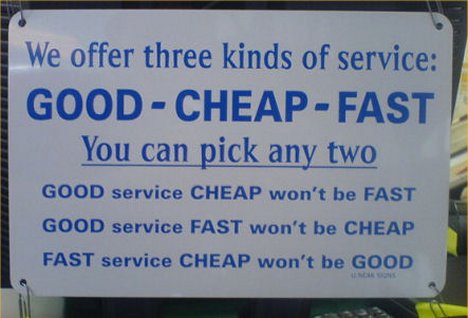What’s New at Kinetic: Building Smart in 2026
At Kinetic, we believe the future of Business Process Management isn’t bigger—it’s smarter.
You may have seen signs like the one below in different types of repair shops in years past. Some rural auto garages still sport them.

You may have seen signs like the one below in different types of repair shops in years past. Some rural auto garages still sport them.
But as the authors of the white paper Humanizing Business Process Automation point out, customers (internal or external) no longer accept the “pick two out of three” perspective. They expect it all. And there are almost certainly competitors of your firm working to deliver on those expectations.
 How can businesses provide outcomes that are better, faster and cheaper all at once? The white paper’s authors, Jesse Clark and Rachel Wentink, write that “Business process automation (BPA) software can improve quality, reduce manual effort and accelerate processes, which are at the heart of good, fast and cheap.” Then they add: “However, software is a tool, not a magic bullet.”
How can businesses provide outcomes that are better, faster and cheaper all at once? The white paper’s authors, Jesse Clark and Rachel Wentink, write that “Business process automation (BPA) software can improve quality, reduce manual effort and accelerate processes, which are at the heart of good, fast and cheap.” Then they add: “However, software is a tool, not a magic bullet.”
Clark and Wentink proceed to outline four key approaches, all of which are components of the enterprise request management (ERM) framework. Reordering their list just slightly, and expanding on their points, the four approaches are:
1. Reverse engineer your process: start with the result of a delighted customer. Simply using technology to automate poorly designed business processes merely enables you to do the wrong thing faster. Before automating anything, take a step back and redesign processes to be ideal from the perspective of the customer (again, internal or external). Then map and automate that process flow (i.e., make the process better, then faster).
2. Lighten the labor intensiveness. This is accomplished in ERM by automating manual approval, scheduling and service fulfillment processes through software wherever possible. Automation reduces costs and accelerates service delivery processes (i.e., cheaper and faster).
3. Reduce mistakes or fix them quickly. Mistakes are often introduced into business processes through redundant, manual data entry. Minimizing the amount of manual data entry required, asking for each piece of required information only once, and validating all data at the point of entry reduces effort and errors (i.e., faster and better).
4. Take an evolutionary approach to process improvement. Within the ERM framework, both quantitative (e.g., time to complete a task) and qualitative (end user satisfaction with the completion of that task) data are collected and reported for analysis (providing information on how to make processes faster and better).
Contrary to the goal of delighting the customer, the authors note that “the primary customer service business strategy for many firms is reducing costs. Instead of leveraging the voice-of-the-customer to fix process problems and build customer loyalty, the firm accepts that customers will have unmet needs, experience problems, and encounter difficulties in doing business,” despite the fact that “study after study presents compelling evidence that long term success is driven by the ability to have happy customers.”
The analytics built into ERM help to continually improve processes once designed, but how do organizations develop customer-centric processes in the first place? Clark and Wentink advise, “Choose a process that’s broken…envision how you would change that process to have a delightful outcome. Focus on the desired outcomes and map out the necessary people, functions, workflow, data, and timing required to achieve the outcome. Leverage the (BPA) tools to communicate the process and use this to drive the necessary organizational changes and technology support.”
A key strategy for reducing both labor intensiveness (either on the part of a service desk representative or the customer) is to simplify the data entry process by pre-populating as many fields as possible. If the employee or customer is logged in, or the system knows some uniquely identifying piece of information about that person (e.g. an ID number), then there’s no need to ask for basic information like name, address and phone number. At most, the employee/customer can be presented with the pre-populated fields and asked to confirm or correct the information.
This is a “three-out-of-three” improvement; it reduces costs (by saving data entry labor), saves time (by requiring less of it to complete a form) and improves quality (by virtually eliminating manual data entry errors, as well as making the experience more pleasant for the customer). Cheaper, faster, better.
Automating common tasks like sending emails requesting approvals—and sending follow-up reminder emails if necessary—also ensures the integrity of processes while saving time and costs by taking the process management burden off of employees (or worse, customers) and making machines do the work.
In short, ERM and BPA can enable organizations to move beyond the “good, cheap, fast: pick any two” mindset and delight customers (while reducing costs) by delivering all three benefits.
To learn more, check out the white papers Enterprise Request Management: An Overview and Business Process Automation Anywhere and Everywhere.
And to keep up with the latest developments, join the Enterprise Request Management Group on LinkedIn.

At Kinetic, we believe the future of Business Process Management isn’t bigger—it’s smarter.

IT support automation uses software workflows, rule engines, AI/ML, and integrations to automate...

Business process reimagined is the strategic renewal of how work gets done by combining modern digital...